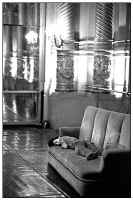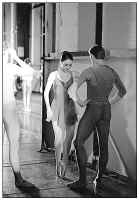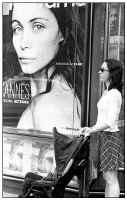
|
p h o t o g r a p h i c e s s a y |
l u c y g r a y |

|
A ballerinaís drive has to be exceptional among dancers if she is to become a principal with the company. There is a profound reward for a dancer who makes it to the top, such that I think itís nearly impossible for the rest of us to appreciate fully. The daring that live performance excites and the satisfaction in having an exchange with an audience is so great that the one true terror for a prima ballerina is that her career will end. Having a baby is one way she can choose to curb her fear. She wouldnít mind her career being over quite so much if she could go home to a family. Thereís a future to which she could look forward. Not that having had a baby means she is ready to leave. Until recently ballerinas at major companies were dropped if they had a child. There were only a rare few exceptions until 1987 when a lawsuit against San Francisco Ballet prompted AGMA, the dancerís union to create the leave of absence clause. The clause is in the template from which all members of AGMA negotiate their contracts with the companies. Itís also true, but for a very few rare exceptions, that a ballerina couldnít be taken seriously if she was also a mother. These days the director of a company is more worried about injuries than image. Helgi Tomasson, the director of San Francisco Ballet, let me come and make a book observing the fact that these three ballerinas are also mothers. If the ballerinas wanted to participate, heíd help. And so he did, by allowing his publicity staff to escort me backstage for performances, by allowing me into any rehearsal, including his own, and by allowing the dancersí children to visit during rehearsals and performances. The pictures in this series are mostly from a Paris tour San Francisco Ballet took in May 2001. They were not included in the ninety-page book proposal now making its way around New York. Unfortunately, you will have to wait for the book to be published to see all three dancers. I have chosen a sequence of thirteen pictures that give a dancerís slice of life. The dancer here is Kristin Long.
|
 or the past two years I have photographed three
prima ballerinas who are mothers at San Francisco Ballet. They are
Tina LeBlanc, Katita Waldo and Kristin Long. Each of these women has
a towering strength both physically and emotionally. No matter how
many years she has been with a company, a dancer takes a class
before she starts work. Lunch is an unnecessary aside when there is
a dance to be learned or rehearsed. A late lunch is far less
important than a visit with a physical therapist or with her child.
And a dancer canít eat before she performs at night. Itíd make
her sick. Instead, she drinks water, water and more water. A dancer
does sweat all day and through the night when sheís dancing. The
water keeps her from getting dehydrated and it fills her tummy.
Where the rest of us have dessert, a prima ballerina has ambition.
or the past two years I have photographed three
prima ballerinas who are mothers at San Francisco Ballet. They are
Tina LeBlanc, Katita Waldo and Kristin Long. Each of these women has
a towering strength both physically and emotionally. No matter how
many years she has been with a company, a dancer takes a class
before she starts work. Lunch is an unnecessary aside when there is
a dance to be learned or rehearsed. A late lunch is far less
important than a visit with a physical therapist or with her child.
And a dancer canít eat before she performs at night. Itíd make
her sick. Instead, she drinks water, water and more water. A dancer
does sweat all day and through the night when sheís dancing. The
water keeps her from getting dehydrated and it fills her tummy.
Where the rest of us have dessert, a prima ballerina has ambition.

